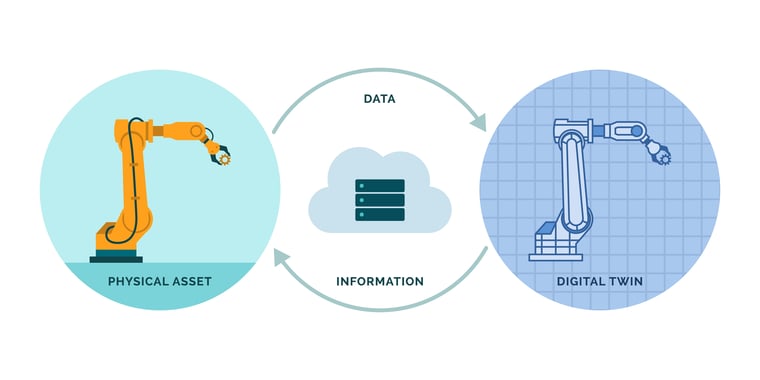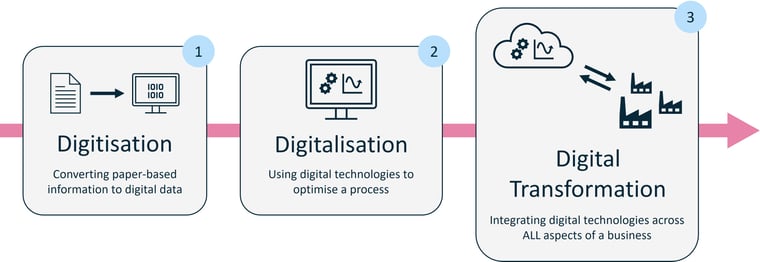
Demystifying the Digital Twin - what it means in manufacturing and how to create one
November 2023
by Mathew Price, Principal Consultant at 42T
One of the most powerful tools in the digitalisation toolkit is the Digital Twin, and with a good understanding of what it is, it’s easy to appreciate its immense value in manufacturing.
.jpg?width=760&height=249&name=shutterstock_2219319867%20(3).jpg)
Numerous articles have been written about the digital future of manufacturing, often covering very broad themes such as ‘Industry 4.0’, ‘Industrial IoT’, ‘Digitalisation’ and ‘Digital Transformation’.
Many are written at a very high level, but they tend to lack detail on the individual tools that are available, their specific benefits and how to go about implementing them.
One of the most powerful tools in the digitalisation toolkit is the Digital Twin, and with a good understanding of what it is, it’s easy to appreciate its immense value in manufacturing.
However, the definition of Digital Twin (and the technologies involved) has evolved greatly over several decades, leading to much confusion over what a Digital Twin actually is.
Currently, different sectors have different definitions of a Digital Twin, although this can also be true for individuals within the same business. This article aims to clarify:
- The specific definition of a Digital Twin within the manufacturing sector, and why you shouldn’t get too hung-up on the name
- Why you should take small steps and consider an agile approach for ‘digitalising’ your manufacturing processes
What is a manufacturing Digital Twin?
After many years of mixed meanings, the manufacturing sector has settled on a single definition of a Digital Twin, which requires all of the following criteria to be met:
- A digital representation of a physical asset, process or system
- Continuously updated with real-time data from the physical asset
- Automatically analyses the data to predict the impact of changing the control parameters
- Automatically controls the physical asset based on its predictions

With this definition, the immense power and value of a Digital Twin is quite obvious:
- Increased throughput and cost reduction through continuous, real-time process optimisation
- Enhanced quality through prediction of defects and preventative control
- Reduced downtime through data-driven predictive maintenance
- Reduced environmental impact through higher efficiency and less waste
Digital Twins are seen as a crucial part in the future of manufacturing, but there is confusion about its definition.
In an attempt to further clarify the definition of manufacturing Digital Twin - and importantly, what it is not - specific names have emerged for two other digitalisation concepts that were commonly misunderstood to be Digital Twins, namely ‘Digital Model’ and ‘Digital Shadow’.
Unfortunately, although these help to clarify the specific definition of a manufacturing Digital Twin, they both suffer from the same problem that initially plagued the Digital Twin – different people have different understandings of their definitions.
Worse though, they exclude many other legitimate concepts that don’t meet any of the three specific definitions. The industry’s understanding and cohesion has taken one step forwards and two steps back.
-1.webp?width=748&height=422&name=shutterstock_2072769434%20(2)-1.webp)
Despite attempts to clarify the definition of a manufacturing Digital Twin not being entirely successful, they have highlighted some important things:
- There are many different levels to ‘digitalising’ a manufacturing process – too many to give individual names to
- You don’t have to choose one of the standard/named concepts and strictly implement every feature exactly as defined. You should instead focus on identifying the individual features that will benefit your business
- If you want to achieve a higher level of digitalisation (like a Digital Twin), it can be achieved by making small incremental steps, rather than taking one giant leap
Even within the specific definition of ‘Digital Twin’ there are different levels of technical capability. For example:
A digital twin doesn't have to include a 3D model and complex multi-physics simulation. It can be a simpler, purely numerical model.
A digital twin doesn't have to use machine learning and artificial intelligence to process the data, it can use traditional (fixed) algorithms that are programmed by a human.
What steps to implementation might make sense?
With a clear(er) understanding of what a manufacturing Digital Twin is, it’s easy to recognise that it can offer potentially game-changing value to manufacturers… especially if it leverages the power of AI. However, the IT infrastructure that is needed to support an advanced Digital Twin can cost millions of pounds, so they are typically being adopted by only the largest and most tech-savvy of global manufacturing companies… for now.
This raises the questions:
- If my organisation has a strong business-case for implementing a Digital Twin, what should we do next?
- If a Digital Twin is unsuitable for my organisation; what should we do instead?
The answer to both questions is, surprisingly, the same:
Because there are many different levels of digitalisation, and many different types of manufacturing business (at different levels of digitalisation), the key is to first define a realistic medium-term goal (whether it has an industry-recognised/named concept, or not) and implement the first features that will create a return on investment in their own right.
Once the first incremental improvement has been completed and verified, you can re-assess the goal and repeat the process, aiming to prioritise the low-cost and high-value critical features first.
This incremental and iterative approach is much like the Agile principles and MVP (Minimum Viable Product) approach that are commonly used in software and product development.
By taking small steps that add value at each step, and repeatedly re-assessing the objective/business-case, you can decide to end the iterative process at any time and still achieve value from it.
Importantly, by designing a flexible system architecture that is intended to evolve, you can stay up-to-date with the rapidly-growing technologies as they emerge, and stay ahead of your competitors!
Capturing good data is the foundation to any digitalisation concept. Therefore, your first pragmatic step might be to assess what data you already gather and identify gaps where more data is needed. Where data is already gathered, you should also check that it’s of sufficient quality and fidelity.
By filling the gaps in data and improving the quality of existing data you are:
- Adding value now, regardless of whether or not you progress all the way to a Digital Twin
- Gaining information to help you assess the business-case for a Digital Twin
Digitalisation strategies for the future
We can help you to create a pragmatic strategy for achieving your digitalisation goals and support you at each step along your implementation journey by combining our:
- Wealth of experience in the manufacturing sector
- Deep understanding of the scientific principles that are fundamental to manufacturing processes
- Broad knowledge of the different technologies for measurement and control
- Understanding of Artificial Intelligence and Machine Learning
Keep an eye out for our next article on Digital Twins, which digs deeper into good data and how to achieve it.
You can also read some of our case studies here or sign up to receive our occasional newsletter if you'd like to know more about future trends and events.
About Mathew
Mat is an experienced engineer with a broad background in product development, mechanical design and manufacturing. He has worked for several product manufacturers and engineering consultancies, gaining significant experience in measurement and control technologies.

If you would like to find out more, please contact Mathew Price:
answers@42t.com | +44 (0)1480 302700 | LinkedIn: Mat
Share this article:
Related Articles

Manufacturing & Automation, Industrial
How to bring sensing in manufacturing out of the lab and onto the line

Manufacturing & Automation
Digitalisation in manufacturing - building on the foundations of good data

Manufacturing & Automation
Food & beverage industry - trends to be aware of in 2024

What will you ask us today?
We believe in asking the right questions to drive innovation; when we know the right questions, we generate the ideas to answer them.


